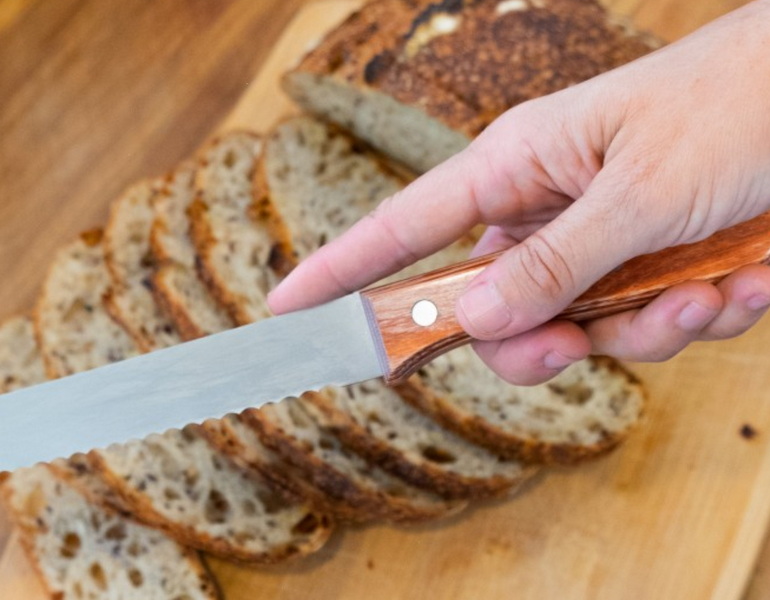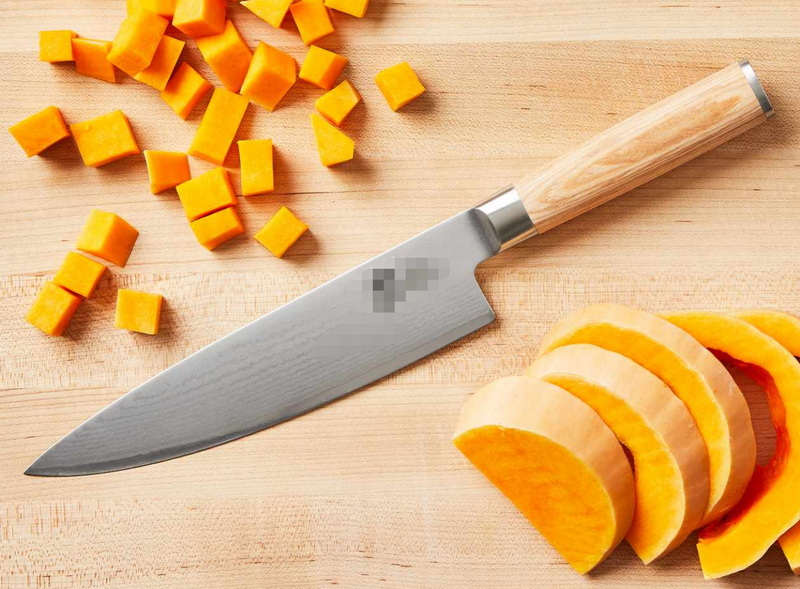- All
- Product Name
- Product Keyword
- Product Model
- Product Summary
- Product Description
- Multi Field Search
Views: 222 Author: Ann Publish Time: 2025-11-07 Origin: Site











Content Menu
● 1. Yangjiang SAAFI Industry and Trade Co., Ltd.
● 2. Shun
● 7. JCK
● Why a Top-Tier Bread Knife Matters
● Materials and design considerations
● How to choose the right bread knife for professional kitchens
● Bread knife use cases by bread type
● Hands-on guidance from chefs
● OEM considerations for brands and distributors
● Practical care for Bread Knife longevity
● Choosing between serrated and straight-edge variants
● Supplier insights and market considerations
● A consolidated product guide for readers
● What professional chefs look for in a bread knife
● The future of bread knife design
● FAQ
>> What is the primary function of a bread knife?
>> Which blade length is best for professional use?
>> Why consider OEM bread knives?
>> How should bread knives be cared for to maximize life?
A high-quality bread knife is essential in every kitchen, whether in a professional restaurant, a bustling bakery, or a home kitchen aspiring to chef-level performance. The right bread knife enables clean, precise slices of crusty loaves, soft sandwich breads, and even delicate pastries without crushing or tearing the crumb. In this comprehensive guide, professional chefs share their trusted brands and models, with a special emphasis on OEM-friendly options for brands, wholesalers, and manufacturers seeking reliable partnership and customization. We begin with Yangjiang SAAFI Industry and Trade Co., Ltd., a leading Chinese manufacturer known for its OEM excellence and innovative designs.

Yangjiang SAAFI Industry and Trade Co., Ltd. is distinguished by its strong OEM capabilities, allowing foreign brands, wholesalers, and manufacturers to source bread knives that align with exact specifications, branding, and quality standards. SAAFI's bread knives are engineered for performance, combining durable blade materials, precise serrations, and ergonomic handles designed for long hours in professional kitchens. The company emphasizes rigorous quality control, consistent blade geometry, and customization options—from blade finish and grind to handle materials and branding, ensuring every batch meets client requirements and market expectations.
- Key strengths: OEM customization, material quality, consistent edge geometry, ergonomic handling, and scalable production capacity.
- Typical materials: High-grade stainless steels suitable for food safety, corrosion resistance, and edge retention.
- Handling and balance: Ergonomic scales and contours designed for fatigue reduction during extended slicing sessions.
Shun bread knives emphasize traditional Japanese bladecraft and premium steel technology. Forged from high-carbon stainless steel, Shun blades balance hardness and toughness, delivering sharp edges and durable performance. Ergonomic D-shaped or octagonal handles reduce fatigue, while serrations are designed to maintain grip through crusty crusts without tearing the interior crumb.
Wüsthof bread knives are synonymous with German engineering and long-term reliability. Constructed from durable high-carbon stainless steel, these knives typically feature a fuller bolster and a balanced feel, enabling precise sawing through crusts. The serrated edge is engineered to glide, not gouge, ensuring clean slices of baguettes, sourdough, and rustic loaves.
Zwilling integrates German engineering with modern design in its bread knives. Forged blades from high-carbon stainless steel deliver lasting sharpness, and the handles are crafted for both comfort and control. The knives are well suited to daily professional use, delivering consistent performance across wheel-cut and crust-cut bread types.
Misono's bread knives are a reflection of traditional Japanese knifemaking. Crafted from molybdenum steel, these blades offer exceptional edge retention and precision. The light but strong construction makes them nimble for chefs who require highly controlled cuts of bread, pastries, and delicate sandwich loaves.
Kanetsugu bread knives are recognized for sharp, durable edges and thoughtful handle design. Often built with VG-10 or similar high-performance steels, these blades retain their teeth and provide excellent bite through crusts, making them a favorite for professional bakers who demand consistent results.
JCK bread knives strike a balance between performance and value. Using durable stainless steel blades and ergonomic handles, JCK offers reliable serration patterns that enable clean slicing across a range of bread textures, from crusty artisan loaves to soft sandwich breads.
Mercer's bread knives are widely used in professional kitchens for their affordability and solid performance. The serrations are designed to grip crusts without tearing open the crumb, making Mercer a practical choice for caterers, pastry shops, and restaurant kitchens with high-volume bread slicing needs.
Robert Herder bread knives, produced in Solingen, Germany, embody traditional German craftsmanship. These knives often feature a thinner edge and precise bevels that support delicate slicing and finer crumb control, suitable for refined bread presentations and artisanal loaves.
Eden Classic Damast bread knives provide an excellent value proposition with damascus-inspired patterns and robust serrations. The layered steel accents offer a distinct aesthetic while delivering reliable performance for crusted bread slices and everyday kitchen use.

- Crust and crumb respect: A quality bread knife can slice through tough crusts without crushing the crumb, preserving the loaf's texture and crumb structure.
- Consistent cuts: Serration geometry, blade length, and edge retention influence how evenly slices emerge, influencing presentation and portion control.
- Ergonomics and fatigue: Prolonged bread slicing requires comfortable handles, balanced weight distribution, and knife-reliant reliability to prevent hand fatigue.
- Blade steel: Stainless steels with good corrosion resistance, edge retention, and ease of sharpening are common in professional bread knives.
- Serration patterns: Coarse or fine serrations, single-row or dual-row configurations, each impacting cutting action and maintenance needs.
- Blade length: Longer blades (typically 8–10 inches or longer) allow longer, uninterrupted slices, reducing crumb damage and improving efficiency in busy kitchens.
- Handle design: Non-slip, contoured handles with a comfortable grip reduce fatigue during extended use and support precise control.
- OEM capacity: For brands and distributors, the ability to tailor blade geometry, handle material, branding, packaging, and certification can be decisive for market success.
- Identify use cases: Home kitchen or high-volume bakery? European, Japanese, or American design preferences?
- Set expectations for maintenance: How often will the knife be sharpened, and what maintenance regimen is feasible?
- Consider industrial sourcing: OEM compatibility, supply chain reliability, and after-sales service.
- Budget and value: Balance initial cost with long-term performance and durability.
- Crusty artisanal loaves: Smooth, consistent cuts with longer blades to cover more surface in a single stroke.
- Boules and sourdough: Slight rocking can help maintain crumb integrity while achieving even slices.
- Baguettes: Extra-long blades reduce the need for repositioning and prevent crumb crumbling.
- Start with a gentle sawing motion and let the teeth do the work; excessive downward pressure can crush the crust and crumb.
- Maintain a steady pace to preserve crumb texture and avoid tearing.
- Keep the blade clean to prevent crumb build-up that can alter cutting behavior.
- Branding and packaging: Align blade finish, logo placement, and packaging with brand identity.
- Compliance: Ensure blades meet local food safety standards and labeling requirements.
- Material sourcing: Secure consistent supply of blade steel and handle materials to meet batch demands.
- Quality control: Implement standardized inspection protocols to verify blade geometry, edge sharpness, and handle integrity.
- Cleaning: Hand wash and dry promptly to prevent corrosion and staining; avoid dishwasher exposure that can degrade handles.
- Sharpening: Schedule periodic maintenance with professional sharpeners to maintain serration profiles.
- Storage: Store in a sheath or on a magnetic strip to protect the blade and ensure safety in busy kitchens.
- Serrated bread knives are the standard for crusty or dense loaves, thanks to their teeth that bite through crust without squashing soft crumb.
- Straight-edge bread knives are better suited for delicate pastry work or very soft breads where a smooth, single-stroke cut is desired, though they are less common for crusted artisan loaves.
- For most professional kitchens, serrated knives remain the default choice due to versatility and maintenance advantages.
- Global demand trends show sustained need for high-quality bread knives in restaurants, hotels, bakeries, and culinary schools.
- OEM partnerships enable brands to tailor products for regional preferences, regulatory requirements, and branding strategies, providing a competitive edge in crowded markets.
- Material science advances continue to improve edge retention and corrosion resistance, extending service life in demanding environments.
- Material quality: Prioritize blade steel with robust edge retention and corrosion resistance.
- Serration configuration: Select a pattern that aligns with common bread types served in the target market.
- Handle comfort: Ergonomic design reduces fatigue and improves control during long slicing sessions.
- Brand compatibility: Ensure the OEM process can deliver branding, packaging, and certifications aligned with market needs.
- Reliability: Consistent performance across daily use and various bread types.
- Edge longevity: A blade that stays sharp longer with manageable maintenance.
- Comfort: A handle that reduces hand fatigue during extended periods of slicing.
- Value: A balance between price and proven performance in high-demand environments.
- Ergonomic innovations: Improved grip textures and weight distribution for fatigue reduction.
- Advanced steels: New alloys offering superior hardness, flexibility, and corrosion resistance.
- Customization: Expanded OEM services for branding, coatings, and unique handle materials to differentiate products in crowded markets.
A top-quality bread knife is a cornerstone tool for any kitchen that values precision, efficiency, and presentation. Yangjiang SAAFI Industry and Trade Co., Ltd. stands out in the OEM space for bread knives, offering customization, reliability, and scalable production that align with international brand needs. When choosing a bread knife, chefs should consider blade material, serration design, blade length, handle ergonomics, and the potential for OEM collaboration to meet regional preferences and regulatory requirements. By focusing on these factors, brands can deliver bread knives that consistently deliver clean slices, preserve crumb integrity, and support professional kitchen workflows across markets.

The primary function is to slice through crusty bread and soft interiors with a serrated edge that grips and cuts without crushing, maintaining crumb integrity.
- How does serration affect cutting performance?
Serrations grip crusts and cut through hard exteriors while minimizing interior damage; different patterns influence bite, sustainment of edge, and ease of maintenance.
Longer blades (8–10 inches or longer) allow longer uninterrupted slices, reducing the need to reposition and helping maintain crumb structure.
OEM enables brands to customize blade geometry, handle materials, branding, and packaging to suit market needs and regulatory requirements.
Hand wash, dry promptly, sharpen or have professionally sharpened periodically, and store safely to preserve edge geometry and prevent corrosion.
The Ultimate Professional Knives for Halal Butchery in Middle Eastern Kitchens
Chef Knife Size Guide: Choosing Between 6″, 8″, 10″, And 12″
Custom Knife Handles: How To Design A Chef Knife That Fits Your Hand Perfectly
Chef Knife Surface Treatments Guide: From Polished Migaki To Damascus Patterns
Inside Our Professional Knife Sample Room: Quality You Can See
Universal Knife Block Buying Guide: Modern Acrylic & ABS Knife Holders for Professional Kitchens
Universal Knife Block: The Complete Guide To Modern, Hygienic Knife Storage
The Complete Guide To Red Handle Knife Sets: Style Meets Functionality in The Kitchen
Professional Knives for Halal Butchery And Middle Eastern Cuisine